A Running Start or a Clean Slate? How a History of Cooperation Affects the Ability of Cities to Cooperate on Environmental Governance
Abstract
:1. Introduction
2. Conceptual Framework
2.1. Autonomous Action in Environmental Governance
2.2. Joint Action in Environmental Governance
2.3. The Effectiveness of Cooperation on Environmental Governance
3. Methods, Case Areas, and Data
3.1. Event Sequence Analysis
3.2. The Case Areas
3.3. Data Collection and Coding
3.4. Data Analysis
4. Empirical Findings
4.1. The Event Graph of Environmental Governance Trajectory in BTH
4.2. The Event Graph of Environmental Governance Trajectory in YRD
4.3. The Participation of Actors in Bringing about Joint Actions
4.4. The Outcomes of Cooperation on Environmental Governance in BTH and YRD
5. Conclusions
Supplementary Materials
Author Contributions
Funding
Acknowledgments
Conflicts of Interest
References
- Liu, H.; Zhou, G.; Wennersten, R.; Frostell, B. Analysis of sustainable urban development approaches in China. Habitat Int. 2014, 41, 24–31. [Google Scholar] [CrossRef]
- Chen, S. Environmental pollution emissions, regional productivity growth and ecological economic development in China. China Econ. Rev. 2015, 35, 171–182. [Google Scholar] [CrossRef]
- Geng, Y.; Sarkis, J.; Ulgiati, S. Sustainability, wellbeing and the circular economy in China and worldwide. Science 2016, 120, 76–79. [Google Scholar]
- State Council of China. The National Plan for New Urbanization (2014–2020); State Council of China: Beijing, China, 2014.
- Central Leading Group for Comprehensively Deepening Reforms. Communique of the third Plenary Session of the 18th Central Committee of the Communist Party; Central Leading Group for Comprehensively Deepening Reforms: Beijing, China, 2014.
- Wu, F. China’s emergent city-region governance: A new form of state spatial selectivity through state-orchestrated rescaling. Int. J. Urban Reg. Res. 2017, 40, 1–18. [Google Scholar] [CrossRef]
- Berardo, R.; Heikkila, T.; Gerlak, A.K. Interorganizational engagement in collaborative environmental management: Evidence from the South Florida Ecosystem Restoration Task Force. J. Public Adm. Res. Theory 2014, 24, 697–719. [Google Scholar] [CrossRef]
- Negev, M. Interagency aspects of environmental policy: The case of environmental health. Environ. Policy Gov. 2016, 26, 205–219. [Google Scholar] [CrossRef]
- Li, Y.; Wu, F. Understanding city-regionalism in China: Regional cooperation in the Yangtze River Delta. Reg. Stud. 2017, 52, 313–324. [Google Scholar] [CrossRef]
- Li, Y.; Xu, J.; Yeh, A.G.O. State rescaling and the making of city-regions in the Pearl River Delta, China. Environ. Plan. C Gov. Policy 2014, 32, 129–143. [Google Scholar] [CrossRef]
- Ansell, C.; Gash, A. Collaborative governance in theory and practice. J. Public Adm. Res. Theory 2008, 18, 543–571. [Google Scholar] [CrossRef]
- Bryson, J.M.; Crosby, B.C.; Stone, M.M. The design and implementation of cross-sector collaborations: Propositions from the literature. Public Adm. Rev. 2006, 66 (Suppl. S1), 44–55. [Google Scholar] [CrossRef]
- Emerson, K.; Nabatchi, T.; Balogh, S. An Integrative Framework for Collaborative Governance. J. Public Adm. Res. Theory 2012, 22, 1–29. [Google Scholar] [CrossRef]
- Koppenjan, J. Creating a playing field for assessing the effectiveness of network collaboration by performance measures. Public Manag. Rev. 2008, 10, 699–714. [Google Scholar] [CrossRef]
- Huxham, C.; Vangen, S. Managing to Collaborate: The Theory and Practice of Collaborative Advantage; Routledge: New York, NY, USA, 2013. [Google Scholar]
- Spekkink, W.; Boons, F.A.A. The emergence of collaborations. J. Public Adm. Res. Theory 2016, 26, 613–630. [Google Scholar] [CrossRef]
- Boons, F.A.A.; Spekkink, W.; Jiao, W. A Process Perspective on Industrial Symbiosis. J. Ind. Ecol. 2014, 18, 341–355. [Google Scholar] [CrossRef]
- Lemos, M.C.; Agrawal, A. Environmental Governance. Annu. Rev. Environ. Res. 2006, 31, 297–325. [Google Scholar] [CrossRef]
- Paavola, J. Institutions and environmental governance: A reconceptualization. Ecol. Econ. 2007, 63, 93–103. [Google Scholar] [CrossRef]
- Ostrom, E. Metropolitan reform: Propositions derived from two traditions. Soc. Sci. Q. 1972, 53, 474–493. [Google Scholar]
- Ostrom, E. Governing the Commons: The Evolution of Institutions for Collective Action; Cambridge University Press: Cambridge, UK, 1990. [Google Scholar]
- North, D.C. Institutions. J. Econ. Perspect. 1991, 5, 97–112. [Google Scholar] [CrossRef] [Green Version]
- McAllister, L.K. Environmental Enforcement and the Rule of Law in Brazil. Ph.D. Thesis, UC Berkeley, Berkeley, CA, USA, 2005. [Google Scholar]
- Weaver, R.K. Compliance regimes and barriers to behavioral change. Governance 2014, 27, 243–265. [Google Scholar] [CrossRef]
- Lipsky, M. Street-Level Bureaucracy. Dilemmas of the Individual in the Public Services; Russell Sage Foundation: New York, NY, USA, 2010. [Google Scholar]
- Wang, X.; Hawkins, C.V.; Lebredo, N.; Berman, E.M. Capacity to sustain sustainability: A study of US cities. Public Adm. Rev. 2012, 72, 841–853. [Google Scholar] [CrossRef]
- Horton, D.; Alexaki, A.; Bennett-Lartey, S.; Kim, N.; Campilan, D. Evaluating Capacity Development: Experiences from Research and Development Organizations around the World; International Development Research Centre: Ottawa, ON, Canada, 2003. [Google Scholar]
- Knoke, D.; Wright-Isak, C. Individual motives and organizational incentive systems. Res. Organ. 1982, 1, 209–254. [Google Scholar]
- Koppenjan, J.; Klijn, E.H. Managing Uncertainties in Networks: A Network Approach to Problem Solving and Decision Making; Routledge: London, UK, 2004. [Google Scholar]
- Klijn, E.H.; Koppenjan, J. Governance Networks in the Public Sector; Routledge: London, UK, 2015. [Google Scholar]
- Feiock, R.C. Metropolitan Governance: Conflict, Competition, and Cooperation; Georgetown University Press: Washington, DC, USA, 2004. [Google Scholar]
- Feiock, R.C. Rational choice and regional governance. J. Urban Aff. 2007, 29, 47–63. [Google Scholar] [CrossRef]
- Feiock, R.C. Metropolitan governance and institutional collective action. Urban Aff. Rev. 2009, 4, 356–377. [Google Scholar] [CrossRef]
- Andrew, S.A. Recent developments in the study of interjurisdictional agreements: An overview and assessment. State Local Gov. Rev. 2009, 41, 133–142. [Google Scholar] [CrossRef]
- Andrew, S.A.; Shout, J.E.; Jung, K.; Arlikatti, S. Intergovernmental cooperation in the provision of public safety: Monitoring mechanism embedded in interlocal agreements. Public Adm. Rev. 2015, 75, 401–410. [Google Scholar] [CrossRef]
- Howlett, M. Designing Public Policies. Principles and Instruments; Routledge: London, UK, 2011. [Google Scholar]
- Hills, P.; Man, C.S. Environmental Regulation and the Industrial Sector in China: The Role of Informal Relationships in Policy Implementation. Bus. Strategy Environ. 1998, 70, 53–70. [Google Scholar] [CrossRef]
- Chisholm, D. Coordination without Hierarchy. Informal Structures in Multiorganizational Systems; University of California Press: Berkeley, CA, USA, 1989. [Google Scholar]
- Putnam, R.D.; Leonardi, R.; Nanetti, R.Y. Making Democracy Work: Civic Traditions in Modern Italy; Princeton University Press: Princeton, NJ, USA, 1995. [Google Scholar]
- LeRoux, K.; Brandenburger, P.W.; Pandey, S.K. Interlocal service cooperation in U.S. cities: A social network explanation. Public Adm. Rev. 2010, 70, 268–278. [Google Scholar] [CrossRef]
- Coleman, J. Social capital in the creation of human capital. Am. J. Soc. 1988, 94, 95–120. [Google Scholar] [CrossRef]
- Coleman, J. Foundations of Social Theory; Belknap Press: Cambridge, MA, USA, 1990. [Google Scholar]
- Lin, N. Social Capital: A Theory of Social Structure and Action; Cambridge University Press: New York, NY, USA, 2001. [Google Scholar]
- Esteve, M.; Boyne, G.; Sierra, V.; Ysa, T. Organizational collaboration in the public sector: Do chief executives make a difference? J. Public Adm. Res. Theory 2012, 23, 927–952. [Google Scholar] [CrossRef]
- O’Leary, R.; Choi, Y.; Gerard, C.M. The skill set of the successful collaborator. Public Adm. Rev. 2012, 72, 70–83. [Google Scholar] [CrossRef]
- Zhu, X. Mandate versus championship: Vertical government intervention and diffusion of innovation in public services in authoritarian China. Public Manag. Rev. 2014, 16, 117–139. [Google Scholar] [CrossRef]
- Vatn, A. Environmental Governance. Institutions, Policies and Actions; Edward Elgar Publishing: Cheltenham, UK, 2015. [Google Scholar]
- Ostrom, E.; Walker, J.; Gardner, R. Covenants with and without a sword: Self-governance is possible. Am. Political Sci. Rev. 1992, 86, 404–417. [Google Scholar] [CrossRef]
- Amirkhanyan, A. Collaborative performance measurement: Examining and explaining the prevalence of collaboration in state and local government performance monitoring. J. Public Adm. Res. Theory 2009, 19, 523–554. [Google Scholar] [CrossRef]
- Amirkhanyan, A. Monitoring across sectors: Examining the effect of nonprofit and for-profit contractor ownership on performance monitoring in state and local government contracts. Public Adm. Rev. 2010, 70, 742–755. [Google Scholar] [CrossRef]
- Keast, R.; Brown, K.; Mandell, M. Getting the right mix: Unpacking integration meanings and strategies. Int. Public Manag. J. 2007, 10, 9–33. [Google Scholar] [CrossRef]
- Bardach, E.; Lesser, C. Accountability in human services collaboratives—For what? And to whom? J. Public Adm. Res. Theory 1996, 6, 197–224. [Google Scholar] [CrossRef]
- Page, S. Entrepreneurial strategies for managing interagency collaboration. J. Public Adm. Res. Theory 2003, 13, 311–339. [Google Scholar] [CrossRef]
- Whitaker, G.; Altman-Sauer, L.; Henderson, M. Mutual Accountability between Governments and Nonprofits: Moving beyond “Surveillance” to “Service”. Am. Rev. Public Adm. 2004, 34, 115–133. [Google Scholar] [CrossRef]
- Provan, K.G.; Kenis, P. Modes of network governance: Structure, management, and effectiveness. J. Public Adm. Res. Theory 2008, 18, 229–252. [Google Scholar] [CrossRef]
- Abbott, A.; Tsay, A. Sequence analysis and optimal matching methods in sociology. Sociol. Methods Res. 2000, 29, 3–33. [Google Scholar] [CrossRef]
- Abell, P. The Syntax of Social Life: The Theory and Methods of Comparative Narratives; Clarendon Press: Oxford, UK, 1987. [Google Scholar]
- Poole, M.S.; van de Ven, A.H.; Dooley, K.; Holmes, M.E. Organizational Change and Innovation Processes: Theory and Methods for Research; Oxford University Press: New York, NY, USA, 2000. [Google Scholar]
- Poole, M.S.; van de Ven, A.H. Handbook of Organizational Change and Innovation; Oxford University Press: New York, NY, USA, 2004. [Google Scholar]
- Spekkink, W. Industrial Symbiosis as a Social Process. Ph.D. Thesis, Erasmus University Rotterdam, Rotterdam, The Netherlands, 2015. [Google Scholar]
- Jiao, W.; Boons, F.A.A. Policy durability of Circular Economy in China: A process analysis of policy translation. Resour. Conserv. Recycl. 2017, 117 Pt A, 12–24. [Google Scholar] [CrossRef]
- Boons, F.A.A.; Spekkink, W.A.H. Internalizing Environmental Responsibility in the Dutch Chemical Industry; Research Report; Dutch Scientific Council for Government Policy: The Hague, The Netherlands, 2015. [Google Scholar]
- Yang, Z.; Cai, J.; Ottens, H.F.L.; Sliuzas, R. City profile: Beijing. Cities 2013, 31, 491–506. [Google Scholar] [CrossRef]
- Wei, Y.D.; Jia, Y. The geographical foundations of local state initiatives: Globalizing Tianjin, China. Cities 2003, 20, 101–114. [Google Scholar] [CrossRef]
- Chang, S.-D. Beijing: Perspectives on preservation, environment, and development. Cities 1998, 15, 13–25. [Google Scholar] [CrossRef]
- Chang, S.-D.; Hu, X.; Sun, J. Tianjin: North China’s reviving metropolis. In China’s Costal Cities; Yeung, Y., Hu, X., Eds.; University of Hawaii Press: Honolulu, HI, USA, 1992; pp. 42–68. [Google Scholar]
- Zhang, T. From intercity competition to collaborative planning. The case of the Yangtze River Delta Region of China. Urban Aff. Rev. 2006, 42, 26–56. [Google Scholar] [CrossRef]
- Li, Y.; Wu, F. The emergence of centrally initiated regional plan in China: A case study of Yangtze River Delta Regional Plan. Habitat Int. 2013, 39, 137–147. [Google Scholar] [CrossRef]
- Qi, Y.; Zhang, L. Local environmental enforcement constrained by central-local relations in China. Environ. Policy Gov. 2014, 24, 204–215. [Google Scholar] [CrossRef]
- Yan, D.; Lei, Y.; Shi, Y.; Zhu, Q.; Li, L.; Zhang, Z. Evolution of the spatial temporal pattern of PM2.5 concentrations in China—A case study from the Beijing-Tianjin-Hebei region. Atmos. Environ. 2018, 183, 225–233. [Google Scholar] [CrossRef]
- Balme, R.; Ye, Q. Multi-level governance and the environment: Intergovernmental relations and innovation in environmental policy. Environ. Policy Gov. 2014, 24, 147–154. [Google Scholar] [CrossRef]
- Verweij, S.; Klijn, E.; Edelenbos, J.; Van Buuren, A. What Makes Governance Networks Work? A Fuzzy Set Qualitative Comparative Analysis of 14 Dutch Spatial Planning Projects. Public Adm. 2013, 91, 1035–1055. [Google Scholar] [CrossRef]
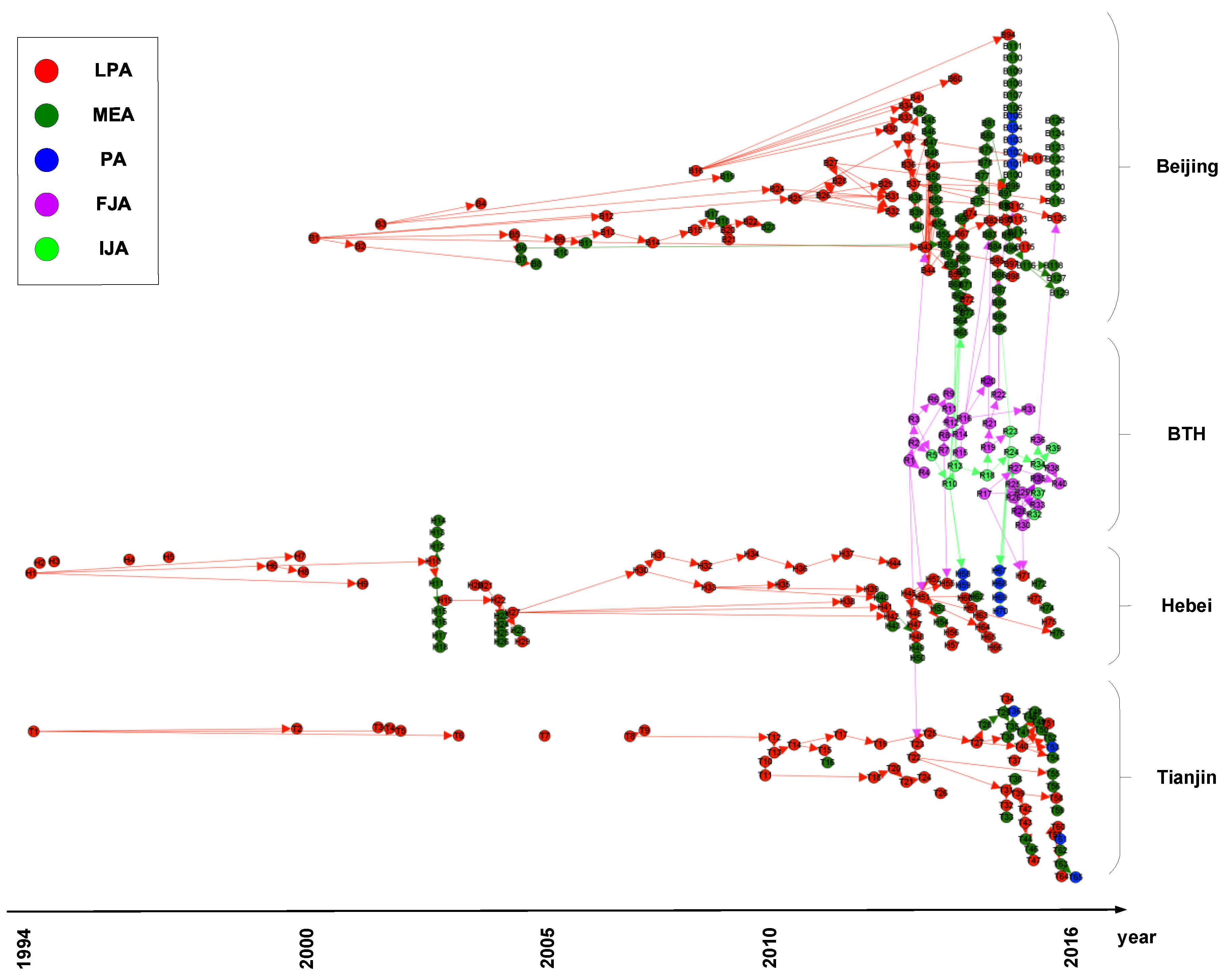
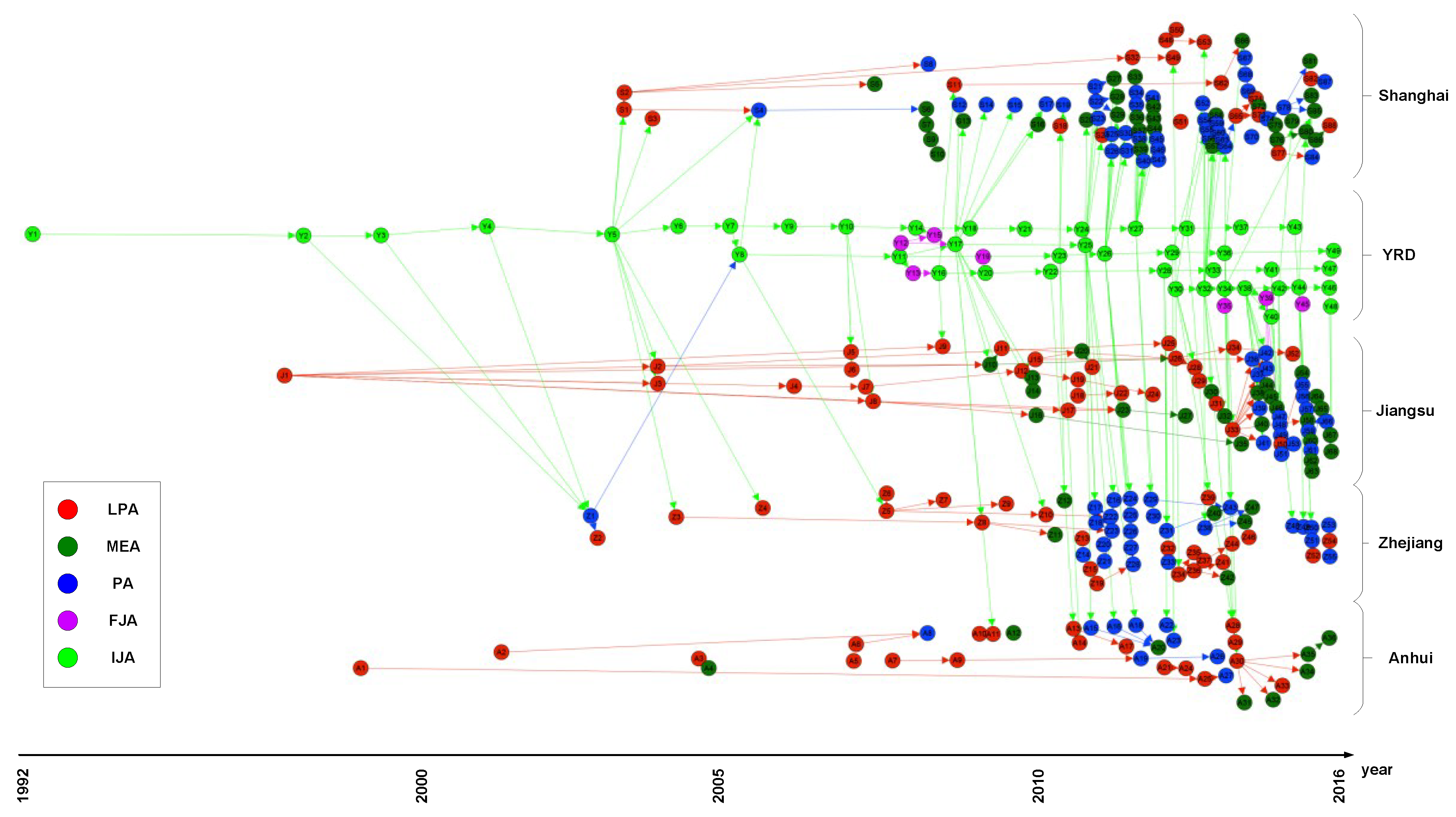
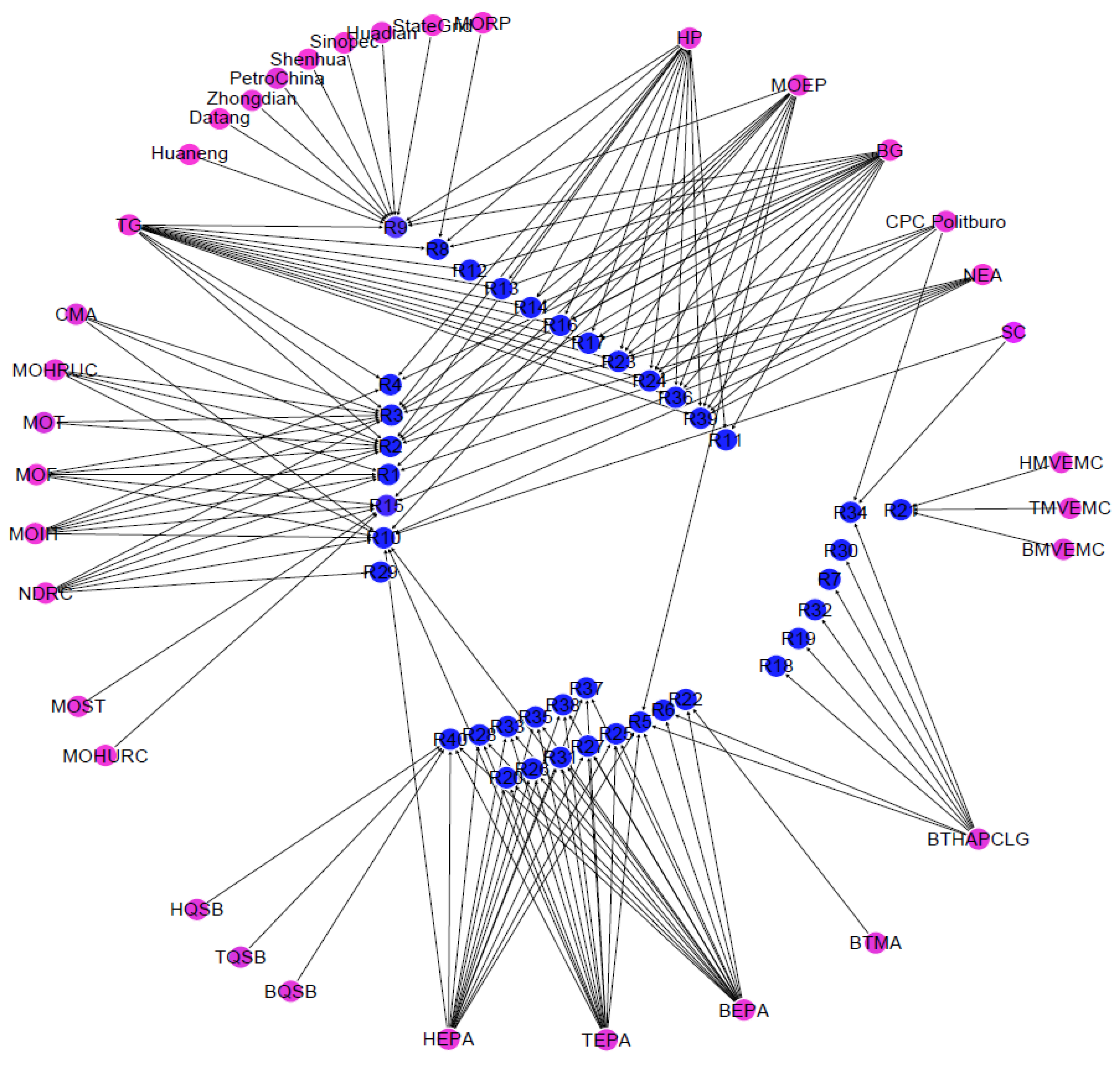
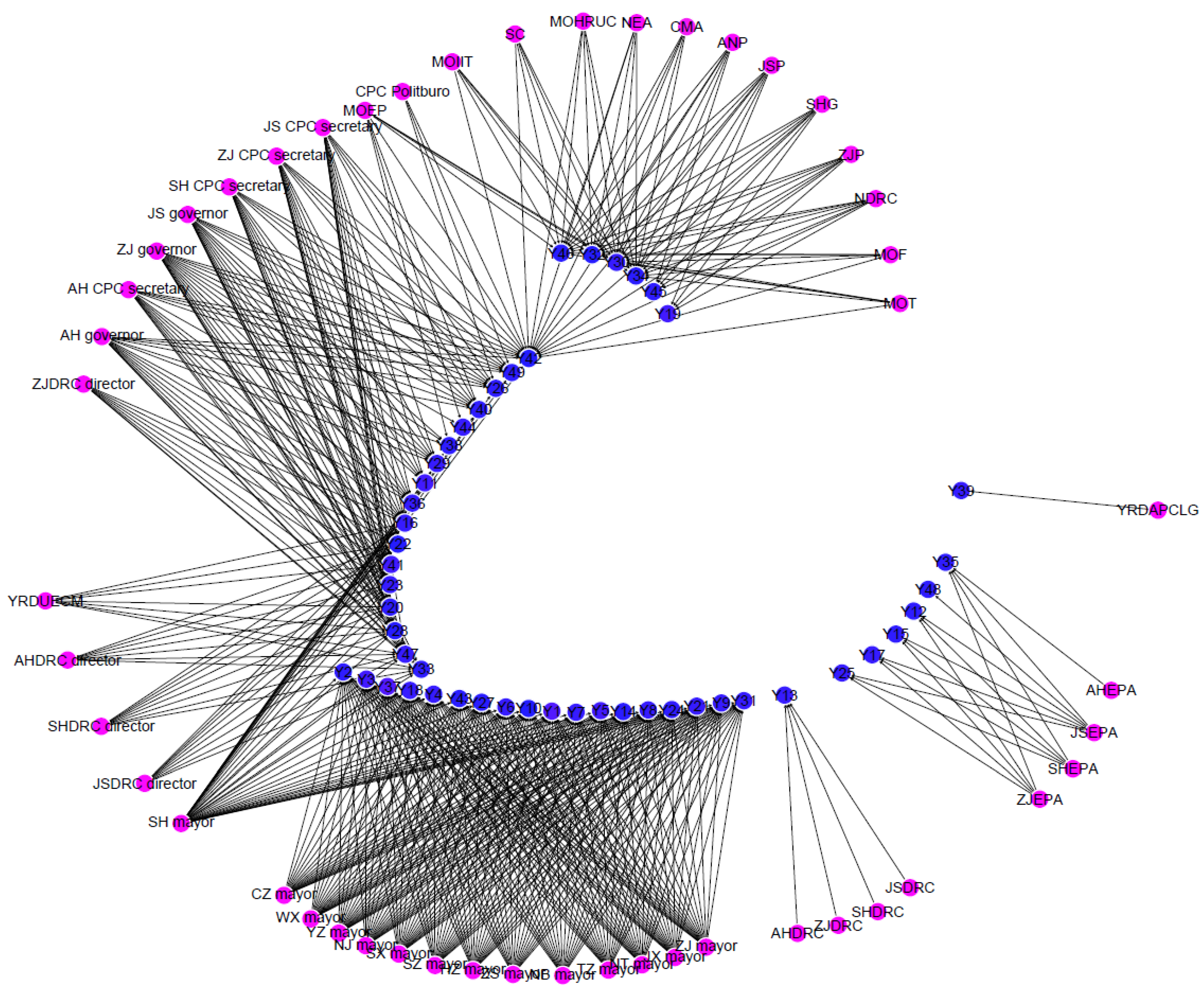
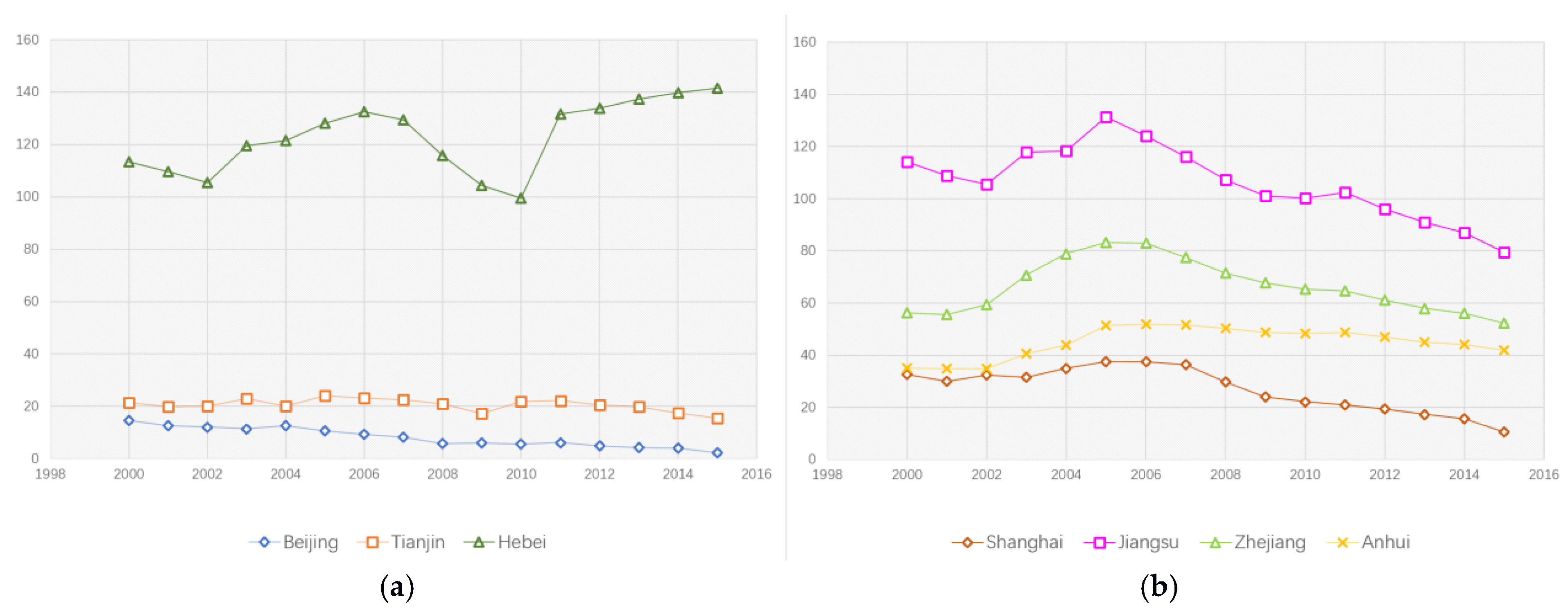
| Action Category | Action Type | Description |
|---|---|---|
| Autonomous actions | Legislative and policy actions (LPA) | Establishment, adaptation or termination of legal prescriptions (including laws, regulations, policies, plans, directives, and formal procedures. |
| Monitoring and enforcement actions (MEA) | Carrying out environmental inspections and carrying out sanctions when the inspected entity breaks environmental regulations. | |
| Political actions (PA) | Political leaders personally carry out surveys or inspections, or political leaders make political statements to incentivize environmental protection. | |
| Joint actions | Formal joint actions (FJA) | The establishment of formal inter-local frameworks and agreements, the establishment of supra-local organizations, associations and/or coalitions, the development of joint projects, plans and programs, and the establishment of information-sharing channels and common goals and visions. |
| Informal joint actions (IJA) | Meetings among major local leaders, and informal oral agreements. |
| Propositions | Indicative Patterns | Analytical Tools | Descriptors |
|---|---|---|---|
| Proposition 1. | Where city-level governance activities follow joint actions, they tend to follow more often from formal joint actions than informal joint actions. | Event Graph | Qualitative description of an event; Directed edges between events. Out-degree of a node: the number of later events, to which an event is related (i.e., a node). |
| Proposition 2. | Where city level governance activities follow joint actions, they tend to follow more often from informal joint actions than formal joint actions. | ||
| Proposition 3. | Joint actions are brought about primarily by supra-local actors. | Two-mode actor-event networks | Attribute of an actor; Edges between actors and joint actions; Betweenness centrality: a node with higher betweenness centrality would have more control over the network, because more information will pass through that node. |
| Proposition 4. | Joint actions are brought about primarily by local actors. | ||
| Proposition 5. | Cooperation in a historical context of no prior cooperation leads to intertwinement of goals of involved actors and reduced or compensated the costs and negative side-effects. | Qualitative assessment | Qualitative description of an event; Directed edges between events. |
| Proposition 6. | Cooperation in a historical context of prior cooperation leads to intertwinement of goals of involved actors and reduced or compensated the costs and negative side-effects. |
| UA | Type of Joint Action (Absolute Amount) | % | Total Number of Following Autonomous Actions | Top 5 Outdegree Joint Actions * | Quantity of Following Autonomous Actions |
|---|---|---|---|---|---|
| BTH | FJA (30) | 75.0% | 13 | R1 | 3 |
| R3 | 2 | ||||
| R7 | 1 | ||||
| R15 | 1 | ||||
| R16 | 1 | ||||
| R17 | 1 | ||||
| R19 | 1 | ||||
| R22 | 1 | ||||
| R29 | 1 | ||||
| R36 | 1 | ||||
| IJA (10) | 25.0% | 13 | R10 | 5 | |
| R23 | 5 | ||||
| R13 | 3 | ||||
| YRD | FJA (7) | 14.3% | 4 | Y39 | 4 |
| IJA (42) | 85.7% | 122 | Y27 | 14 | |
| Y17 | 12 | ||||
| Y26 | 12 | ||||
| Y25 | 11 | ||||
| Y32 | 11 |
| UA | Actor | Betweenness Centrality | No. Joint Actions in Which Actor Participates |
|---|---|---|---|
| BTH | MOEP | 21.583 | 12 |
| BEPA | 6.477 | 15 | |
| TEPA | 6.477 | 13 | |
| HEPA | 6.477 | 13 | |
| BG | 5.009 | 15 | |
| TG | 5.009 | 14 | |
| HP | 5.009 | 14 | |
| NDRC | 1.511 | 6 | |
| MOIIT | 1.511 | 6 | |
| MOF | 1.511 | 5 | |
| YRD | SH mayor | 31.763 | 34 |
| JS CPC secretary | 0.811 | 14 | |
| ZJ CPC secretary | 0.811 | 14 | |
| SH CPC secretary | 0.811 | 14 | |
| AH CPC secretary | 0.811 | 15 | |
| JS governor | 0.811 | 16 | |
| ZJ governor | 0.595 | 17 | |
| AH governor | 0.595 | 15 | |
| ZJDRC director | 0.017 | 8 | |
| SHDRC director | 0.017 | 8 |
© 2018 by the authors. Licensee MDPI, Basel, Switzerland. This article is an open access article distributed under the terms and conditions of the Creative Commons Attribution (CC BY) license (http://creativecommons.org/licenses/by/4.0/).
Share and Cite
Mu, R.; Spekkink, W. A Running Start or a Clean Slate? How a History of Cooperation Affects the Ability of Cities to Cooperate on Environmental Governance. Sustainability 2018, 10, 1950. https://doi.org/10.3390/su10061950
Mu R, Spekkink W. A Running Start or a Clean Slate? How a History of Cooperation Affects the Ability of Cities to Cooperate on Environmental Governance. Sustainability. 2018; 10(6):1950. https://doi.org/10.3390/su10061950
Chicago/Turabian StyleMu, Rui, and Wouter Spekkink. 2018. "A Running Start or a Clean Slate? How a History of Cooperation Affects the Ability of Cities to Cooperate on Environmental Governance" Sustainability 10, no. 6: 1950. https://doi.org/10.3390/su10061950





